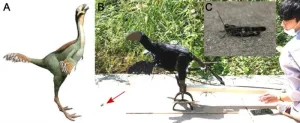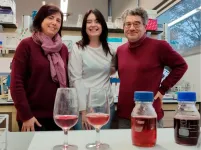(Press-News.org) FOR IMMEDIATE RELEASE
Working with mammalian retinal cells, neuroscientists at Johns Hopkins Medicine have shown that, unlike most light-sensing cells (photoreceptors) in the retina, one special type uses two different pathways at the same time to transmit electrical “vision” signals to the brain. The work also reveals that such photoreceptors, according to the researchers, may have ancient origins on the evolutionary scale.
This and other findings, published Dec 18, in PNAS, “shed scientific as well as literal light” on a decades-long mystery about how such cells work, the researchers say.
The new research was co-led by King-Wai Yau, Ph.D., professor in the Department of Neuroscience at the Johns Hopkins University School of Medicine, and postdoctoral fellow Guang Li. King’s previous work led to advances in understanding how light-sensing cells in the mammalian eye transmit signals to the brain, findings that may eventually help scientists learn why people without sight can still sense light.
In animals, including humans, photoreceptors (light-sensing cells) called rods and cones are located in the retina, a tissue layer at the back of the eye that responds to light. The rods and cones analyze visual signals that are transmitted via electrical signals to the brain, which interprets what is “seen.”
Another type of photoreceptors in the retina, called intrinsically-photosensitive retinal ganglion cells (ipRGCs), use long protrusions (axons) that form the optic nerve to convey visual signals from rods and cones. The ipRGCs also perform other functions, such as setting the body’s light-driven circadian rhythms and distinguishing contrast and color.
It has been known that photoreceptors in animals detect light by using a signaling pathway named for the cell’s origin. Photoreceptors of “microvillous” origin, similar to those in the fruit fly eye, use the enzyme phospholipase C to signal light detection — whereas, photoreceptors of ciliary origin, such as those in our rods and cones, use a cyclic-nucleotide pathway. To signal light detection, most photoreceptors use either the microvillous or ciliary pathway, not both. However, in experiments to further understand how ipRGCs work, Yau’s team found that ipRGCs use both pathways at the same time.
The researchers discovered this by exposing ipRGCs to brief pulses of bright light. In those conditions, the microvillous signaling pathway produces faster electrical responses and precedes, with some overlap, a slower response by the ciliary pathway.
Yau’s team found that all six subtypes of ipRGCs use both microvillous and ciliary signaling mechanisms — although at different percentages — at the same time.
The Johns Hopkins team also found that while most photoreceptors using the ciliary signaling pathway use a particular cyclic nucleotide, cGMP, as the signaling messenger, ipRGCs use another, cAMP, which is similar to jellyfish, an animal much older on the evolutionary scale. This suggests that ipRGCs may have an ancient origin.
Other Johns Hopkins researchers who contributed to this study are Lujing Chen and Zheng Jiang.
This study was funded by a grant from the National Institutes of Health (R01 EY014596) and a Beckman-Argyros Award in Vision Research.
END
Retinal photoreceptors use dual pathways to tell brain ‘I’ve seen the light!’
Johns Hopkins neuroscientists show how specialized cells signal the presence of light simultaneously in two distinct ways
2024-01-25
ELSE PRESS RELEASES FROM THIS DATE:
GSA members call on senate to support higher standards for assisted living facilities
2024-01-25
Speaking today at a hearing of the U.S. Senate Special Committee on Aging, Gerontological Society of America members Jennifer Craft Morgan, PhD, FGSA, and Richard J. Mollot, JD, called on lawmakers to enact policies that enable greater state and national oversight of assisted living facilities, and that bolster the workforce and engagement of residents and care partners.
Senators convened the hearing, titled “Assisted Living Facilities: Understanding Long-Term Care Options for Older Adults,” to examine challenges faced by assisted living facility residents. Committee Chair Bob Casey recently sent letters to the CEOs of three ...
American College of Radiology releases joint statement on the use of AI tools in radiology
2024-01-25
Philadelphia, January 25, 2024 – The American College of Radiology® (ACR®), working in close collaboration with four other radiology societies from around the world, have issued a joint statement on the development and use of artificial intelligence (AI) tools in radiology. This groundbreaking joint statement is openly available in ACR’s Journal of the American College of Radiology, published by Elsevier. It explores the potential challenges and ethical and safety concerns related to integrating this new technology into radiology practice.
“Developing, Purchasing, Implementing and Monitoring AI Tools ...
Advancements in IBD care: Natural supplements, disease monitoring via sweat and more
2024-01-25
Las Vegas, NV (Jan. 25, 2024) — The Crohn’s & Colitis Foundation® and the American Gastroenterological Association (AGA) are proud to host the annual Crohn’s & Colitis Congress®, taking place on Jan. 25-27, 2024, in Las Vegas. The Crohn’s & Colitis Congress convenes researchers, clinicians, and other professionals involved in the care of patients with inflammatory bowel disease (IBD) to share the latest research breakthroughs and treatment advancements in IBD. During this premier meeting, we’ll review the latest advancements in IBD care that aim to improve the lives of the millions of Americans living with Crohn’s disease ...
These male marsupials give up sleep for sex
2024-01-25
All animals need sleep. When humans or animals don’t get enough, it can lead to trouble paying attention, irritability, and other ill effects. And yet, researchers reporting in the journal Current Biology on January 25 have made the surprising discovery that a small Australian marsupial called an antechinus will sacrifice hours of sleep per night to make more time for sex during the mating season.
The researchers say the multi-year study is the first to show direct evidence for this type of sleep restriction in any land-dwelling mammal. It’s a trade-off between sleep and reproduction that they say is likely driven by ...
Dinosaurs might have used feathers on forelimbs and tails to flush and pursue their prey – a new hypothesis integrates morphology, behavior and neurobiology
2024-01-25
What are the origins of wings and tails in birds? This is one of the key questions in the evolution of animals. It has long been accepted that their evolution began in feathered dinosaurs. Some of these dinosaurs had feathers on the tails and small wing-like feathers on their forelimbs (arms). These small wing-like structures called ‘proto-wings’ are composed of special feathers known as pennaceous feathers — the stiff feathers found in the wings and tails of birds. The ancient form of these feathers first emerged in dinosaurs during the Jurassic Period, and these dinosaurs, called ...
Palaeontology: Small dinosaurs flapped their feathers to scare prey
2024-01-25
Small omnivorous and insectivorous dinosaurs may have flapped small, feathered primitive wings to scare prey out of hiding places, according to a study published in Scientific Reports. The authors built a robot dinosaur named Robopteryx to investigate how grasshoppers responded to different potential scaring behaviours, and speculate that the results could help explain why feathered wings evolved before they were capable of flight in some types of dinosaurs.
Although the remains of numerous species of feathered dinosaurs have been discovered, so far only members of one group of dinosaurs known as ...
Gaps in the vision screening pathway for school-aged children
2024-01-25
About The Study: The current approach to vision screening in the U.S. may not adequately provide care to all children. At each stage along the care pathway, children from historically marginalized racial and ethnic groups, low-income households, and non–English language speakers experience worse outcomes—they were less likely to receive screening, more likely to be referred for failed screening, and less likely to establish care with a specialist. High referral rates in these vulnerable groups may suggest higher prevalence of undiagnosed conditions or elevated false-positive results from suboptimal screening strategies.
Authors: Isdin Oke, M.D., M.P.H., ...
Suicidal thoughts and trajectories of psychopathological and behavioral symptoms in adolescence
2024-01-25
About The Study: This study of 2,780 adolescents found that persistent withdrawn symptoms and increasing somatic symptoms during early to mid-adolescence were associated with an increased risk of suicidal thoughts in mid-adolescence, even after accounting for comorbid symptoms and confounders. Attention should be paid to the suicidal risk associated with these symptoms, particularly when they persist or increase in the longitudinal follow-up.
Authors: Shuntaro Ando, Ph.D., of the University of Tokyo, is the corresponding author.
To ...
An unconventional yeast increases the quality of carbonic maceration wine, rosé wine and orange wine
2024-01-25
Carbonic maceration wines are increasingly in demand on the market. They are young red wines in which floral and fresh fruit aromas predominate and they must be consumed within the first year. The best-known example is Beaujolais nouveau in France, but there is also a tradition in La Rioja and Catalonia, especially in the Montsant area and the Conca de Barberà.
Research by the URV has found that the quality of these wines can be increased by using an unconventional yeast that considerably improves their organoleptic properties and speeds up the malolactic fermentation process. ...
BU’s Thanh Nguyen, MD, elected President of the Society of Vascular and Interventional Neurology
2024-01-25
FOR IMMEDIATE RELEASE, January 25, 2024
Contact: Gina DiGravio, 617-358-7838, ginad@bu.edu
BU’s Thanh Nguyen, MD, Elected President of the Society of Vascular and Interventional Neurology
First woman to serve as president of the society
(Boston)—Thanh N. Nguyen, MD, FRCP, FSVIN, FAHA, professor of neurology, radiology and neurosurgery at Boston University Chobanian & Avedisian School of Medicine, has been elected President of the Society of Vascular and Interventional Neurology (SVIN), the first woman to serve in this role in its 17-year history.
Previously, Nguyen was an elected board member of SVIN in 2008 and ...
LAST 30 PRESS RELEASES:
When is it time to jump? The boiling frog problem of AI use in physics education
Twitter data reveals partisan divide in understanding why pollen season's getting worse
AI is quick but risky for updating old software
Revolutionizing biosecurity: new multi-omics framework to transform invasive species management
From ancient herb to modern medicine: new review unveils the multi-targeted healing potential of Borago officinalis
Building a global scientific community: Biological Diversity Journal announces dual recruitment of Editorial Board and Youth Editorial Board members
Microbes that break down antibiotics help protect ecosystems under drug pollution
Smart biochar that remembers pollutants offers a new way to clean water and recycle biomass
Rice genes matter more than domestication in shaping plant microbiomes
Ticking time bomb: Some farmers report as many as 70 tick encounters over a 6-month period
Turning garden and crop waste into plastics
Scientists discover ‘platypus galaxies’ in the early universe
Seeing thyroid cancer in a new light: when AI meets label-free imaging in the operating room
Neutrophil-to-lymphocyte ratio may aid risk stratification in depressive disorder
2026 Seismological Society of America Annual Meeting
AI-powered ECG analysis offers promising path for early detection of chronic obstructive pulmonary disease, says Mount Sinai researchers
GIMM uncovers flaws in lab-grown heart cells and paves the way for improved treatments
Cracking the evolutionary code of sleep
Medications could help the aging brain cope with surgery, memory impairment
Back pain linked to worse sleep years later in men over 65, according to study
CDC urges ‘shared decision-making’ on some childhood vaccines; many unclear about what that means
New research finds that an ‘equal treatment’ approach to economic opportunity advertising can backfire
Researchers create shape-shifting, self-navigating microparticles
Science army mobilizes to map US soil microbiome
Researchers develop new tools to turn grain crops into biosensors
Do supervised consumption sites bring increased crime? Study suggests that’s a myth
New mass spec innovation could transform research
Maternal nativity, race, and ethnicity and infant mortality in the US
Migration-related trauma among asylum seekers exposed to the migrant protection protocols
Jupiter’s moon Europa has a seafloor that may be quiet and lifeless
[Press-News.org] Retinal photoreceptors use dual pathways to tell brain ‘I’ve seen the light!’Johns Hopkins neuroscientists show how specialized cells signal the presence of light simultaneously in two distinct ways


